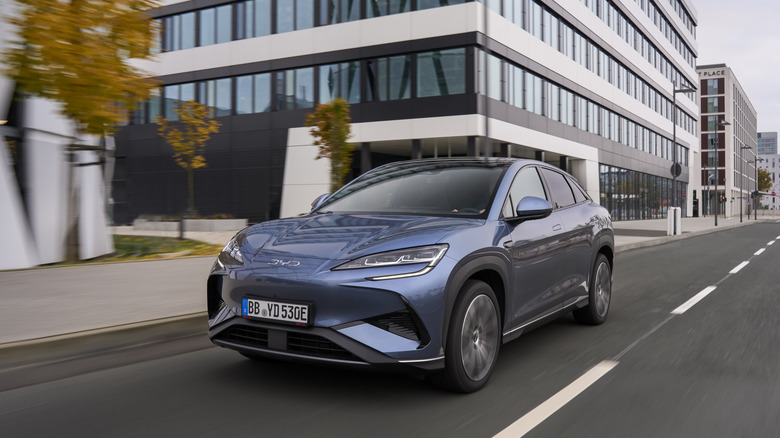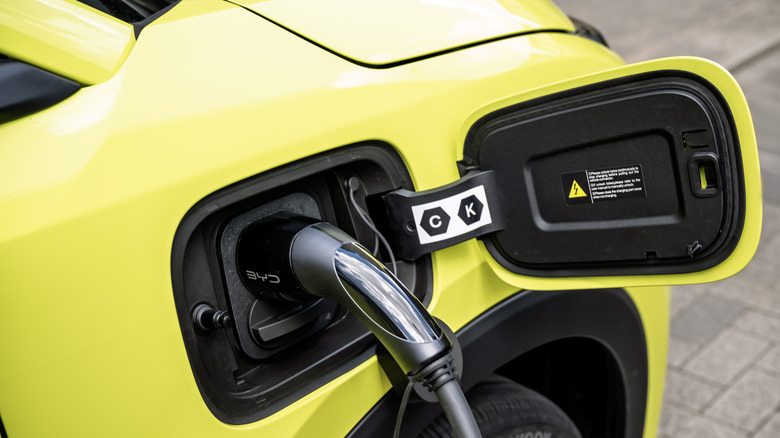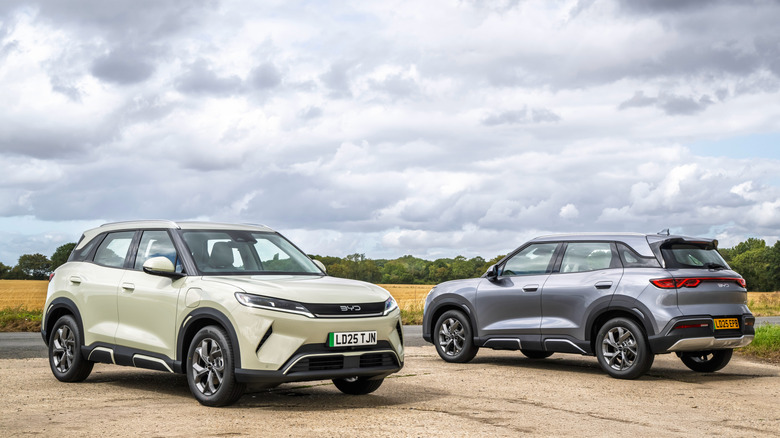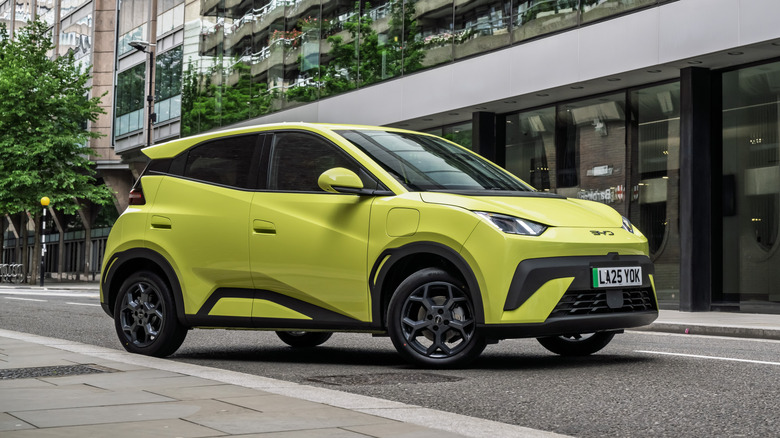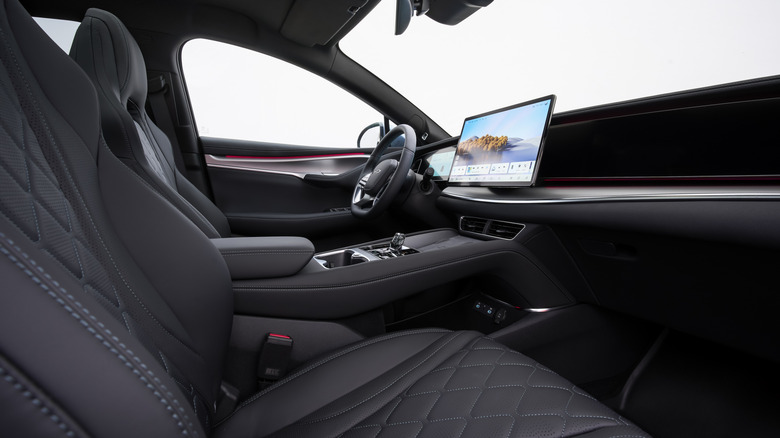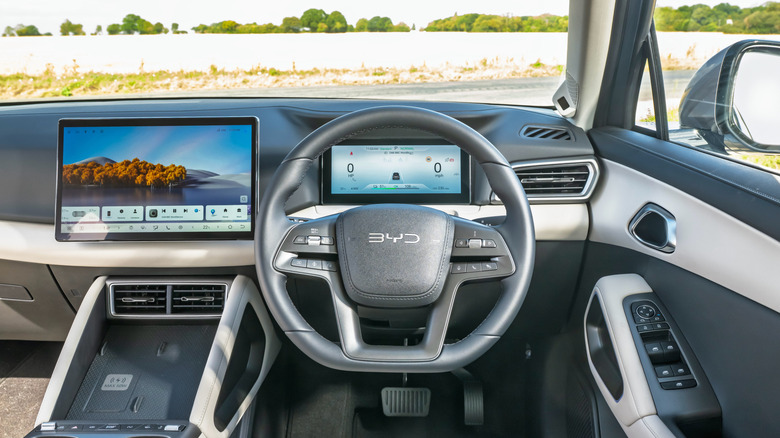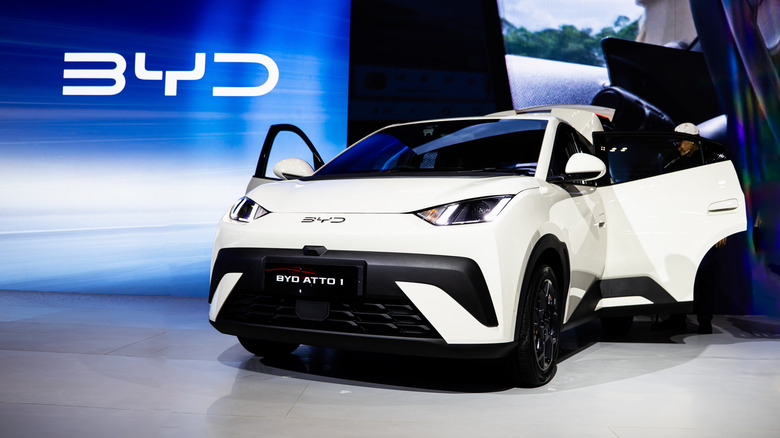4 Reasons China's BYD EV Is One Step Ahead Of Tesla (According To Reviews)
With the electric vehicle arms race in full swing, more manufacturers are getting in on the action than ever, and everyone has something interesting to bring to the table. One of the most ubiquitous, inexpensive, and advanced among the many options is BYD, a Chinese EV manufacturer directly competing with the likes of Tesla in many parts of the world. Standing for "Build Your Dreams," BYD is a multinational company owned by billionaire entrepreneur Wang Chuanfu that specializes in battery EVs and plug-in hybrid models. It's also China's best-selling car brand, surpassing Volkswagen in 2023, and the most popular EV manufacturer in the world.
Because EVs have such a huge market share, as well as the global demand for EVs being on the rise, it's no surprise that BYD is so incredibly popular. But how does it compete against the American-produced Tesla in a direct comparison? While BYD isn't nearly as well-known in the U.S. market, it still faces off against the American juggernaut on the world stage, including within China itself. In these cases, the BYD carries a remarkable amount of advantages over various Tesla models, namely the popular Models 3 and Y. Being the most perennial, family-oriented of the Tesla lineup, let's take a look at each of these side-by-side with their respective BYD counterparts and weigh one against the other.
This comparison will pit each model in isolation from its parent companies, disregarding aspects such as economic factors aside from the MSRP costs of each vehicle in countries where both manufacturers have a presence.
BYD offers better battery technology and infrastructure
Arguably, the most important component of any electric vehicle is the battery used to power it; unlike Tesla, BYD utilizes its own in-house battery materials and manufacturing, cutting costs and middlemen from the equation. BYD's custom battery, the Blade, claims to redefine battery safety standards, able to withstand being burned, crushed, and deformed without any fire or explosion, factors affecting Teslas to the point where there's a dedicated website, tesla-fire.com, for tracking individual incidents and their causes. That isn't to say that a Tesla is inherently dangerous, just more energy-dense.
The inherent volatility is largely eliminated through the use of a less energy-dense core, which means that while the battery carries less range, it's also less prone to combustion. This means no complex cooling systems, better heat dissipation, and a wider appeal to safety-conscious owners for the family-oriented market when compared to Tesla.
Of course, it's not a perfect solution; again, there's a relative lack of range against Tesla, which pushes energy density to a higher priority. But the range matters relatively little when China has an incredibly robust EV charging network, including five-minute charging stations, versus the American market, with a fraction of China's. To put it into perspective, China has somewhere north of 13 million public charging points versus the United States — 230,000 as of April 2025. There are few places where a car with 265 miles of range can't go when you have infrastructure like that, though range anxiety is still a problem in other parts of the world.
BYD's models are ridiculously cheap, but only in some markets
Believe it or not, affordable electric midsize SUVs do actually exist. BYD's answer is the Sealion 6, an all-electric SUV with a price that's lower than almost any car offered in America, period, to the tune of less than $20,000. Of course, this car is only available in China, sadly; nevertheless, it represents that budget-friendly family-oriented electric cars can actually find their footing, an important footnote when the average new car price in the U.S. is about $50,000. Largely due to the 100% tariffs, if BYD ever exported these vehicles to American markets, they would likely never be available for their original MSRP, being more in line with a high-spec Tesla Model Y.
Elsewhere in the world, BYD cars boast incredible savings over Teslas, sometimes halving the purchase price in places like Thailand, Mexico, and Malaysia. This is likely partly due to the company specializing in compacts and city-cars, such as the BYD Seagull, a $10,000 EV that's superficially similar to a shrunken Chevrolet Bolt.
This price point doesn't carry over everywhere in the world, however. For one, it depends on what the distributor actually sells the car for; Tesla sells directly to consumers, whereas BYD relies on a network of local distributors for its pricing. In the UK, for example, it's actually cheaper to buy a Tesla Model 3 than it is the BYD Seal, the Chinese equivalent in the Model 3's class.
BYD offers a wider range of models
Aside from how ridiculously inexpensive BYD cars are in China's domestic market, BYD also produces far more models than Tesla. Let's discount the Cybertruck because that's its own thing — what else does Tesla offer? Its lineup consists of four models, all of relatively similar sizes and designs: Models Y, X, S, and 3, respectively. The Y and X are both crossover-sized midsize models, with the gullwing-door Model X being more of a crossover/sedan hybrid with its lack of a wagon-style rear end.
Conversely, BYD offers no fewer than eight models in China, nine in mainland Europe, including a PHEV, seven in Hong Kong, and so on. Likely the models themselves are tailored to the regions in which they're being sold, though they cover the full range of every body type, including city cars, compacts, minivans, and a diverse array of SUVs and crossovers. Moreover, even the cheapest models, like the Seagull have been praised by reviewers for their levels of quality. BYD didn't overlook performance, either — If money is no object, BYD's next electric hypercar promises to raise the bar in terms of performance figures: enter the Yangwang U9 Track Edition, packing a quad-motor setup purportedly good for nearly 3,000 horsepower. Just one of many cool Chinese cars we wish were sold stateside.
Yangwang, by the way, is just one of the numerous subsidiary manufacturers operating under the BYD umbrella. For example, BYD owns Denza, buying the electric company from Daimler in 2024. Moreover, BYD operates numerous successful commercial ventures, including truck, bus, and electronics research institutes. As a whole, BYD represents a generally broader and more economically diverse company than Tesla, and that is reflected in its equally expansive cars and brand names.
BYD's interiors have superior layouts and comparable quality
If there's one thing Tesla interior design is known for, it's minimalism to the extreme. The interiors are so bare that they don't even feature instrument clusters anymore, just a long, stylized crash bar where the dashboard goes, along with a centrally placed tablet. Apart from looking like something resembling a rollercoaster's retainer, this design choice is arguably borderline dangerous, demanding drivers glance over to the middle of the car to view its vital functions like speed and charge without a heads-up display. Almost every function has been moved to that tablet, in fact, including the vehicle's drive mode selector.
BYD, however, opts for a far more intuitive and car-like design, utilizing a traditional centrally-mounted shift handle, ergonomic controls, and tasteful design language — although it's arguably more "traditional," if not regressive, in this respect. BYD also enjoys praise for its interior quality, being at least comparable to equivalent Tesla models. Reviewers have praised its design language as being both restrained and intuitive, rating it favorably against Tesla's. Considering the fact that a BYD sells for about half that of the average Tesla in some parts of the world, with the Seagull topping the list of cheap Chinese EVs, having similar grades of interior with arguably more intuitive features is a huge plus.
Taking price out of consideration and comparing two similarly-equipped models, the difference between a Tesla and BYD is striking when viewed from the driver's seat. The Tesla almost looks unfinished in comparison to a BYD, missing several important aspects we've learned to associate with interior design in favor of streamlining and minimalism. While that may be to some people's tastes, it's certainly unconventional and might be somewhat tricky for some people to understand in comparison to the BYD.
BYD models come equipped with a plethora of features as standard
This one falls in line with the price point mentioned earlier. What would one expect to get from Sealion 7 Premium single-motor, a car that sells for about $5,000 cheaper in Australia than the Tesla Model Y RWD? Actually similar, if not more, bang for your buck — for instance, the BYD comes standard with leather interior, 12-speaker audio, and a heads-up display; all of which are absent or a downgrade on the Tesla equivalent. Likewise, both models sport similar levels of electronic integration, including large-screen tablets, ergonomic heated seats, and so on — all the usual appointments one would expect of a luxury family-oriented EV.
Granted, that isn't to say that the Tesla equivalent is without modern conveniences and features — bearing in mind that it doesn't have a wiper stalk, mind you. That aside, owing to Tesla migrating almost everything to its tablet, it does boast a better layout than BYD's, according to reviews. Of course, Tesla's in-house OS still doesn't accept Apple CarPlay, but nobody's perfect.
Overall, both BYD and Tesla offer compelling options to people looking for EVs for different reasons. BYD's models typically lean on the side of more budget-conscious, practical individuals, whereas Teslas utilize the robust Supercharger network, coupled with boundary-pushing features like the nascent self-driving capabilities to their utmost ability. Much of both companies' models feature little overlap apart from the fact that they both specialize in EVs, though the internet consensus is that BYD can come close to, even match, the far pricier Tesla. And that's not even counting its subsidiaries like Denza, which now competes with its former owners.
Our methodology
We scoured the Internet for sources from both owners and experts concerning all relevant BYD models, including accredited reviews and automotive journals. We also took care to look past the political biases regarding Tesla to stick to only the facts regarding these vehicles' design choices, for better or worse, and how they relate to comparable BYDs.
Seeing as BYD offers a more diverse range of budget-friendly options than Tesla, we felt it prudent to do direct comparisons between similarly-sized models built for similar purposes. As such, certain factors such as interior design language, power figures, and general quality may vary from model to model.
Our sources number in the dozens, including various owner testimonials, videos, official media, opinion pieces, and more. With so much discourse available on these two vehicles, we cut through the fat of the favoritism and took an honest look at both sides of the fence, doing our best to remain as fair, comprehensive, and objective as possible in our assessments.
